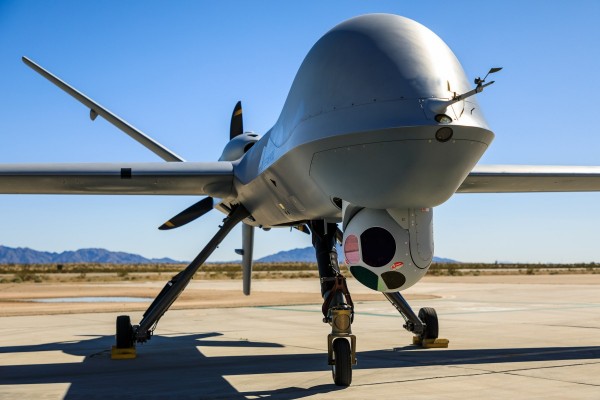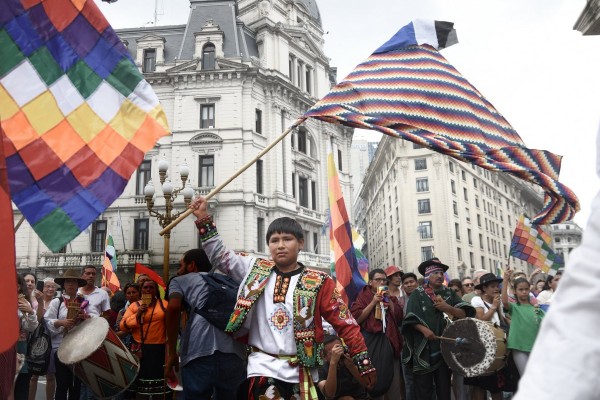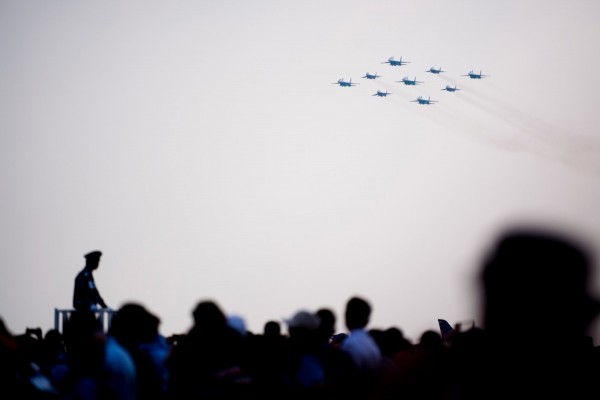Canada joins US in militarizing the Pacific
How the Canadian Armed Forces are exacerbating tensions in the region

Ships from the US Navy, Japan Maritime Self-Defense Force, Royal Australian Navy, and Royal Canadian Navy during Annual Exercise (ANNUALEX) 19. US Navy photo courtesy of Japan Maritime Self-Defense Force/Flickr.
Having visited and helped peace activists on Okinawa over the past 25 years, we can attest to the beauty of that island whose lands and seas are as beloved to the Indigenous Uchinanchu as the Salish Sea is to First Nations.
Okinawans, Indigenous and non-Indigenous alike, have been fighting to rid the island of US bases for decades, giving rise to one of the strongest peace movements in the world, attracting broad international support.
Thus, we were doubly shocked to learn that the Canadian Armed Forces are regularly using US military installations on Okinawa today, including the infamous Kadena Air Base that has been the site of repeated mass demonstrations for decades.
Okinawa is the main island of 221 that make up the Ryukyu island chain.
Canadian naval ships as well as CP-140 Aurora surveillance aircraft have been sent to Okinawa, 700 miles south of Japan, as part of Operation Neon and Operation Projection. These are military projects that, according to the Canadian military, are enforcing sanctions against North Korea, reinforcing partnerships with military allies, or reinforcing “the rules-based international order.”
Okinawa scholar and activist Yonaha Keiko told us that she contested such assertions: “Due to the presence of the US military, many other violations of international and domestic laws are taking place in Okinawa, which is under the control of the US and its client state Japan. The fundamental problem is that US exceptionalism is allowed to flourish. Canada, Australia, and the UK all work under US command in NATO, don’t they?”
US film director Oliver Stone in Okinawa with Satoko Norimatsu at Okinawa Peace Memorial Park in a 2013 media scrum, explaining why Stone supported the Okinawan peace movement.
Canadian Armed Forces in Asia
In the skies near Japan recently, Chinese military jets buzzed a Canadian CP-140 Aurora maritime patrol aircraft, forcing it to divert from its flight path in late May. Canada’s Department of National Defence (DND) accused the Chinese aircraft of not adhering to air safety norms and jeopardizing the safety of the Canadian air crew.
Prime Minister Justin Trudeau subsequently branded the Chinese actions “irresponsible and provocative,” asserting the aircraft were on a United Nations mission to enforce sanctions against the Democratic People’s Republic of Korea (DPRK).
The Chinese government responded in kind, stating the Canadian aircraft were stepping up risky provocations: “The UN Security Council has never authorized any country to carry out military surveillance in the seas and airspace of other countries in the name of enforcing sanctions.”
The dangerous skirmish between Chinese and Canadian military aircraft points to the continuing crisis in Canada-China relations. It also reveals the real risks that accompany increasing militarization of the region.
To be sure, the United Nations has invoked sanctions against the DPRK, but there is no UN mission to enforce these sanctions. Instead, US armed forces, with their extensive military empire in Asia, are taking matters into their own hands, hoping to thus legitimize their huge presence in the region.
Unfortunately, the Japanese government has participated in this charade, claiming the “Agreement Regarding the Status of the United Nations Forces in Japan” (1954) is the basis of the Canadian Armed Forces, as well as the UK, Australia and France, using the US Air Force’s Kadena base in Okinawa.
That is why the International Association of Democratic Lawyers and the Confederation of Lawyers of Asia and the Pacific wrote early this year to the United Nations pointing out “abuse of the UN flag by the so-called ‘United Nations Command’ (‘UNC’), which is not a UN entity under control of the United Nations, in South Korea and Japan today, in violation of the new UN Flag Code.”
The ‘UN Command’ is, in fact, under United States military control and the United Nations has sought to distance the organization from the US military in Asia. Thus in 1975, the General Assembly urged South and North Korea to continue talks so “that the United Nations Command may be dissolved.”
In 1994, then UN secretary general Boutros Boutros Ghali stated:
However, allow me to recall that the Security Council, in operative paragraph 3 of resolution 84 (1950) of 7 July 1950, limited itself to recommending that all members providing military forces and other assistance to the Republic of Korea make such forces and other assistance available to a unified command under the United States of America. It follows, accordingly, that the Security Council did not establish the unified command as a subsidiary organ under its control, but merely recommended the creation of such a command, specifying that it be under the authority of the United States.
As the US steps up military intervention in the region, the ‘UN Command’ is a useful fiction to incorporate allies such as Canada into the US military system, providing the illusion of a multinational UN presence. But under this veil of imagined multilateralism lurks more a more strategic and dangerous agenda.
The USS Wilbur conducts replenishment at sea with Japanese and French ships. Photo courtesy US Navy.
Confronting a rising China
Four years ago, the Canadian Armed Forces dispatched HMCS Vancouver and a CP-140 Aurora aircraft to Okinawa under Operation Projection to “defend Canada’s interests around the world,” and to “enhance relationships with Canada’s allies and partners.”
Behind the spin is an overt attempt to work with the US to intimidate the People’s Republic of China. Take for example, naval operations that took place last fall that had nothing to do with enforcing UN sanctions.
Just last October, HMCS Winnipeg joined a flotilla of 17 warships from the US, the UK, Japan, New Zealand, and the Netherlands that included two US carrier strike groups, the United Kingdom’s Carrier Strike Group 21 (CSG21), and a Japanese large-decked warship in a major naval exercise in the waters off the southeast of Okinawa.
As CBC reporter Murray Brewster pointed out, the joint naval exercise was designed to send “a stark warning to China.” Brewster interviewed the commander of the British naval task force, Commodore Steve Moorhouse, who stated: “It’s an important message for those here that nations like ourselves really do believe in the freedom of navigation, in the freedom of trade and really are alarmed at the militarization of the area.”
Suggesting that militarization of the area is a recent event so distorts history that it would be laughable were it not for the fact that US-led forces in the Pacific have at their fingertips the firepower that could reduce a city to ashes in minutes.
Asia Pacific militarization
The US and its allies regularly point to China as an expanding military power that is a major threat in the Asia Pacific. For those who care to look, however, such accusations are out of proportion given the US military empire that extends from Hawai’i right to the shores of China.
Calling the shots in this empire is not some fictitious ‘UN Command,’ but what the US today calls its calls its Indo-Pacific Command (USINDOPACOM) that, according to the US military, includes: “375,000 US military and civilian personnel including US Pacific Fleet of approximately 200 ships (including five aircraft carrier strike groups), nearly 1,100 aircraft, and more than 130,000 sailors and civilians; Marine Corps Forces, Pacific with two Marine Expeditionary Forces and about 86,000 personnel and 640 aircraft; US Pacific Air Forces comprised of approximately 46,000 airmen and civilians and more than 420 aircraft; US Army Pacific has approximately 106,000 personnel, plus over 300 aircraft and five watercraft; more than 1,200 Special Operations personnel; Department of Defense civilian employees in the Indo-Pacific Command AOR number about 38,000.”
Nowhere in this military profile is there a single mention of ‘UN Command.’

As pointed out by the Rideau Institute’s Peggy Mason, “in the Asia Pacific, American bases virtually encircle China.”
The US empire in the Asia Pacific has a long history beginning with its illegal annexation of Hawai’i in 1897, accelerating throughout the 20th century, and intensifying in 2012 with the “Pivot to Asia.”
The Japanese armed forces have also been accelerating their seamlessness and interoperability with the US military in recent years, deploying new missile and electronic warfare bases along the chain of Ryukyu Islands between Taiwan and Kagoshima, including Amami, Okinawa, Miyako, Ishigaki, and Yonaguni Islands, to threaten China’s routes out to the Pacific Ocean.
That China, now the second-largest economy in the world, has reacted negatively to such increases in military pressure is hardly surprising. Canadians would also react if China sent aircraft carriers to patrol in the Salish Sea. This is not say that no security questions exist in East Asia—clearly, they do, but they can be handled regionally without US meddling.
Some may be surprised by how quickly the Canadian government is incorporating its Pacific forces with those of US, surrendering any vestiges of an independent foreign policy. Gone are the days, it seems, when Lester Pearson had the temerity to criticize Lyndon Johnson for the war in Vietnam, when Pierre Trudeau stood up to Richard Nixon on Cuba, or when Jean Chrétien refuted George Bush and Tony Blair and refused to endorse the US invasion of Iraq.
That the Canadian Armed Forces proudly provide pictures like the ones above to conservative Japanese newspapers, depicting Canadian frigates deployed with Japanese naval vessels flying the Rising Sun, is especially tone deaf given how Japan’s imperial forces flying that same flag were responsible for the deaths of at least 10 million Chinese after Japan launched its all-out invasion of China in 1937.
Under Justin Trudeau and Chrystia Freeland, Canada is becoming completely aligned with the US empire, to the detriment of a peaceful Pacific.
Adding insult to injury is Canadian use of American military facilities on Okinawa such as Kadena, or the US naval port of White Beach. It betrays an astonishing lack of judgement given the history of US colonization of the islands, and the accompanying dispossession of the Indigenous Uchinanchu population of Okinawa.
The Canadian government might want to consider the recent appeal by the Okinawan peace organization “No More Okinawa-Sen (Battle of Okinawa): Nuchi du Takara (Life is a Treasure) People’s Alliance,” which recently wrote an “Open Letter to Biden on Using Okinawa as an Attack Base against China,” pointing out that Okinawans refuse to be cannon fodder for Japan and the US if a military conflict erupts over Taiwan.
Still suffering from intergenerational trauma of war and occupation, the voices of Indigenous Okinawans deserve to be heard by all Canadians.
John Price first visited Okinawa in 2000 to create a huge human chain surrounding the US-controlled Kadena Air Base. He is the author of Orienting Canada: Race, Empire and the Transpacific (UBC Press) and an advisor to the project Canada-China Focus.
Satoko Oka Norimatsu has been part of the international solidarity movement for Okinawa since 2009. She is co-author of Resistant Islands: Okinawa Confronts Japan and the United States (Rowman and Littlefield), an editor of the Asia Pacific Journal: Japan Focus, and coordinator of the International Network of Museums for Peace.










